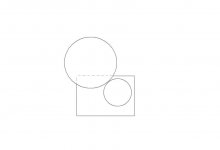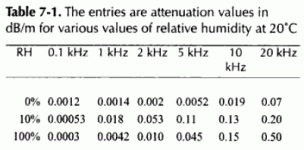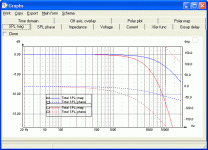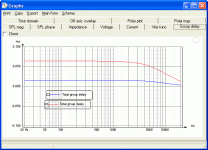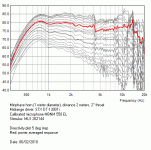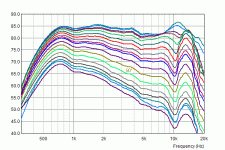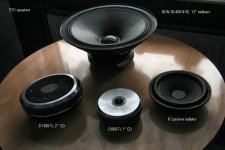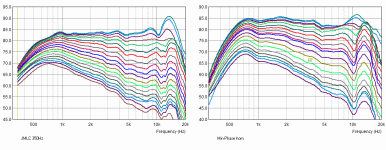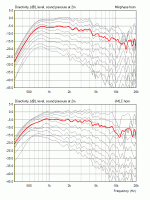Michael, I can see why Earl gets frustrated trying to discuss (argue) wave theory with you.
...
Their theory works, yours doesn't.
.
Hi Catapult – you possibly got me wrong.
...and Earl – I think - simply is frustrated as I found the more intuitively way to explain what's going on with "diffraction", quite antithetic to all his statements and his philosophy to "avoid diffraction at any price" in general.
As far as I remember, there absolutely was no need to solve any wave equations to come to that point.
Like wise - I wasn't aware (until now) we need to study quantum physics to get a good understanding of what's involved with "speed of sound" – do we?
If you had actually read and understood the Wikipedia article on speed of sound, beyond the first couple of sentences that mention the spring and balls, you would have seen the dynamic behavior of fluids and solids explained well enough (with the math) to understand that there is clearly a time component in the dynamic behavior and that the 'speed of sound' is quite real.
.
Well - what I can see is that there are formulas provided – but nothing of explanation or understanding beyond that. So I'd say, the author didn't have any deeper understanding on the topic "speed of sound" – its simply a copy and paste compilation – good for a quick superficial look up or the need for some calculation but a perpetuation of wrong *concepts*.
But to stay at topic :
I never said there is no "time of flight".
What I said is that:
There is no way to explain "time of flight" by the "mass spring chains"
– or in other words – the sentence I cited from wiki in my last posting is right away misleading and faulty in the very context.
Its not even an analogy ("illustration" as they call it) as the core - about how "time delay" or "speed of sound" is involved - is missing completely - or better put – heavily misinterpret.
The claim
"The speed of sound through the model depends on the stiffness of the springs (stiffer springs transmit energy more quickly). Effects like dispersion and reflection can also be understood using this model."
is simply way off - among others.
When you talk of time then what are you actually talking about? nobody really knows, it is nevertheless a useful concept.
rcw.
Well I guess in the end we are involved in that – time of flight– you remember?
In classical mechanics there must be time delay in acceleration.
if you write f=ma, as f=m [dv/dt], if there is no passage of time acceleration becomes infinite, and so does the force needed to cause the acceleration.
rcw.
This does not enlighten me – to be honest.
Especially this conclusion does not make sense to me:
" acceleration becomes infinite, and so does the force needed to cause the acceleration."
" f=m [dv/dt] "still is a linear equation found to be valid usually – and I can't see the point where it adds to how speed of sound can be explained or understood.
On the other hand making time *infinite small* does not mean making time *zero*
If we make time small (dt = close to zero) velocity becomes small too – but still – there is *no delay* - meaning - acceleration and thus movement happens instantaneous.
Michael
Well, its not to be negative
But woofer and waveguide does look like mismatched
Like something that will never intgrate well
Dunno, but a big waveguide on woofer might help
Also, having midrange from a driver placed close to floor might not work too good either
Maybe you have just created your own problem and gone too far when making a horn that big
Might work better with a cone driver, and small tweeter
But woofer and waveguide does look like mismatched
Like something that will never intgrate well
Dunno, but a big waveguide on woofer might help
Also, having midrange from a driver placed close to floor might not work too good either
Maybe you have just created your own problem and gone too far when making a horn that big
Might work better with a cone driver, and small tweeter
Last edited:
Well, its not to be negative
But woofer and waveguide does look like mismatched
Like something that will never intgrate well
Dunno, but a big waveguide on woofer might help
Also, having midrange from a driver placed close to floor might not work too good either
Maybe you have just created your own problem and gone too far when making a horn that big
Might work better with a cone driver, and small tweeter
Hi tinitus - you might well be right - but its not exactly *my* design as I have been asked to calculate the contour but was not involved in any further design decisions at all.
If *we* were asked to start from scratch - what you think might turn out well with that given horn ?
Michael
Of course there is, at least in a crude 1-dimensional visualization. The period of oscillation of a ball on a spring is t = 2pi*sqrt(m/k) where m is mass of the ball and k is the spring constant (stiffness) with units mass/time-squared. In air, where the period of oscillation of the 'balls' (molecules) is much shorter than the period of any audio wave, the resulting lowpass filter acts as a pure group delay and phase-shift effects can be ignored.There is no way to explain "time of flight" by the "mass spring chains"
To Thadman.
The parabolic approximations have inaccuracies in phase, and conservation of energy, the phase effect is very small for an approximation using several terms in a Pade series.
You can look at this as a dispersive effect, in as much as it varies with frequency, but it can be made very small, and is swamped by the actual dispersive effect of a horn.
To Micheal
All that I can say is to look up the work of Ludwig Boltzmann. He was the Austrian physicist who did the work on statistical mechanics that leads to the correct,( given certain limitations), figure for the speed of sound.
It is basically the average molecular velocity of a gas and varies as the square root of the absolute temperature, (given the aforementioned conditions).
rcw.
The parabolic approximations have inaccuracies in phase, and conservation of energy, the phase effect is very small for an approximation using several terms in a Pade series.
You can look at this as a dispersive effect, in as much as it varies with frequency, but it can be made very small, and is swamped by the actual dispersive effect of a horn.
To Micheal
All that I can say is to look up the work of Ludwig Boltzmann. He was the Austrian physicist who did the work on statistical mechanics that leads to the correct,( given certain limitations), figure for the speed of sound.
It is basically the average molecular velocity of a gas and varies as the square root of the absolute temperature, (given the aforementioned conditions).
rcw.
Hi tinitus
I have been asked to calculate the contour but was not involved in any further design decisions at all.
If *we* were asked to start from scratch - what you think might turn out well with that given horn ?
Michael
Oh, thats a tricky one
Maybe not simple
Oval design might have helped, but not an option
Maybe try something like this
Its rough and done in a hurry
Maybe try and angle horn and woofer slightly towards each other
And consider to have listening height/horn midpoint placed slightly above normal listening height
Apart from other possible advantages it will help getting woofer a bit higher up
Attachments
Last edited:
What I wrote above isn't strictly true. While it's true that each 'ball' (molecule) acts as a lowpass filter with a resonant frequency far, far above the audio range, if you stack enough of those filters together (more balls on a longer spring), the combined effect will move the lowpass down into the audio range so there will be some attenuation and phase shift of high frequencies relative to the low frequencies. The biggest effect is the group delay due to all the stacked filters but the HF roll-off can be a big deal in a large stadium. The pic from the Handbook for sound engineers shows the typical lowpass effect.In air, where the period of oscillation of the 'balls' (molecules) is much shorter than the period of any audio wave, the resulting lowpass filter acts as a pure group delay and phase-shift effects can be ignored.
Attachments
What I wrote above isn't strictly true. While it's true that each 'ball' (molecule) acts as a lowpass filter with a resonant frequency far, far above the audio range, if you stack enough of those filters together (more balls on a longer spring), the combined effect will move the lowpass down into the audio range so there will be some attenuation and phase shift of high frequencies relative to the low frequencies. The biggest effect is the group delay due to all the stacked filters but the HF roll-off can be a big deal in a large stadium. The pic from the Handbook for sound engineers shows the typical lowpass effect.
Always thought this is due to *absorption* effects ?
############
Wow, started to get familiar with Austrian Ludwig Eduard Boltzmann (1844-1906) by reading his curriculum vitae last night and got impressed on a how widely interdisciplinary range this famous guy actually has been working.
Boltzman constant and Stefan-Boltzmann law being only the tip of the iceberg.
Ludwig Boltzmann – Wikipedia
Ludwig Boltzmann - Wikipedia, the free encyclopedia
Haven't arrived at what his theories may explain in the context of "speed of sound" though.
So – maybe a question beforehand – that from a mass spring chain some low pass filter and subsequent group delay occurs is clear (thend having outlined as well) but what's actually the trick that allows to flip from "group delay" to a "real delay" to establish "time of flight".
I mean - this crazy guy has published a looooooot – or is the explanation I seek for kind of "evident" – or maybe my question is kinda stupid?
############
Tinitus your suggestion looks reasonable to me – especially as I guess (in lack of measurements) the sweet range of this large min phase horn may be somewhere three (maybe four) octaves above 600-800Hz with smooth roll off above that.
So rising the mid-bass from the floor might be a good idea.
Michael
Last edited:
Always thought this is due to *absorption* effects ?
In the electrical/mechanical model, the absorption effects are caused by the lowpass filter.
Wow, started to get familiar with Austrian Ludwig Eduard Boltzmann (1844-1906) by reading his curriculum vitae last night and got impressed on a how widely interdisciplinary range this famous guy actually has been working.
Boltzman constant and Stefan-Boltzmann law being only the tip of the iceberg.
Ludwig Boltzmann – Wikipedia
Ludwig Boltzmann - Wikipedia, the free encyclopedia
Haven't arrived at what his theories may explain in the context of "speed of sound" though.
The Boltzman constant for a gas replaces the spring constant in the mass-spring model.
So – maybe a question beforehand – that from a mass spring chain some low pass filter and subsequent group delay occurs is clear (thend having outlined as well) but what's actually the trick that allows to flip from "group delay" to a "real delay" to establish "time of flight".
Group delay IS a real delay for a lowpass filter at low frequencies and goes to zero at high frequencies.
We've really gone beyond where the mass-spring model is useful but let's stick with it for a moment. The pics show the frequency response and group delay of 1 ball (blue) and 4 balls (red) with a resonance frequency of 10 KHz. Notice how the F3 moves lower and the group delay (real delay) grows larger at low frequency as you add more balls and a longer spring.
If you could build a molecular-size spring-balls gizmo, it might have an F3 for each ball in the GHz range. If you make it very long, say millions of balls, the combined F3 will start to shift down into the audio range and the combined group (real) delay will increase to measurable levels.
Attachments
At the time the atomic theory was still doubted by many and the only model of the atom was an ideal perfectly elastic indivisible sphere, first proposed by the Greeks thousands of years before.
I think it was first Boltzmann who pointed out that since they knew that oxygen and nitrogen were diatomic, a more suitable model for them would be a pair of such spheres connected by a rigid rod.
This would explain why the speed of sound obtained by Newton was in error, he had considered only single spheres with three degrees of freedom and a diatomic molecule would have five.
This also partially explains the effect of water vapour on the speed of sound, the water molecule would have six degrees of freedom, and the speed of sound would vary in accordance with the partial pressures of these three gasses.
Later Van der Vaals showed that molecules have a fractional surface charge that causes interactions other than plain momentum preserving perfect impulse collisions.
All of this is very interesting but not really relevant for audio since the model of connected elastic spheres en mass acting statistically as waves in a smooth medium is perfectly adequate.
rcw.
I think it was first Boltzmann who pointed out that since they knew that oxygen and nitrogen were diatomic, a more suitable model for them would be a pair of such spheres connected by a rigid rod.
This would explain why the speed of sound obtained by Newton was in error, he had considered only single spheres with three degrees of freedom and a diatomic molecule would have five.
This also partially explains the effect of water vapour on the speed of sound, the water molecule would have six degrees of freedom, and the speed of sound would vary in accordance with the partial pressures of these three gasses.
Later Van der Vaals showed that molecules have a fractional surface charge that causes interactions other than plain momentum preserving perfect impulse collisions.
All of this is very interesting but not really relevant for audio since the model of connected elastic spheres en mass acting statistically as waves in a smooth medium is perfectly adequate.
rcw.
STX DT-1300Ti is a driver prototype made for me by STX Soundstation, probably most affordable, high-quality on the market. Smaller brother is here:
D-800-Ti - Sklep internetowy
D-800-Ti - Sklep internetowy
Attachments
Gaussian MinPhase Horn
Where it all started from:
http://www.diyaudio.com/forums/multi-way/103872-geddes-waveguides-67.html#post1930266




Above is not exactly the same Gaussian MinPhase contour thats finally been realized and what we now got measurements for – but might give some background nevertheless

Thanx again, jzagaja - great work !
Michael
Where it all started from:
http://www.diyaudio.com/forums/multi-way/103872-geddes-waveguides-67.html#post1930266




Above is not exactly the same Gaussian MinPhase contour thats finally been realized and what we now got measurements for – but might give some background nevertheless
Thanx again, jzagaja - great work !
Michael
- Status
- This old topic is closed. If you want to reopen this topic, contact a moderator using the "Report Post" button.
- Home
- Loudspeakers
- Multi-Way
- Min Phase Horn with Faital Drivers at German DIY Show in Gelsenkirchen
